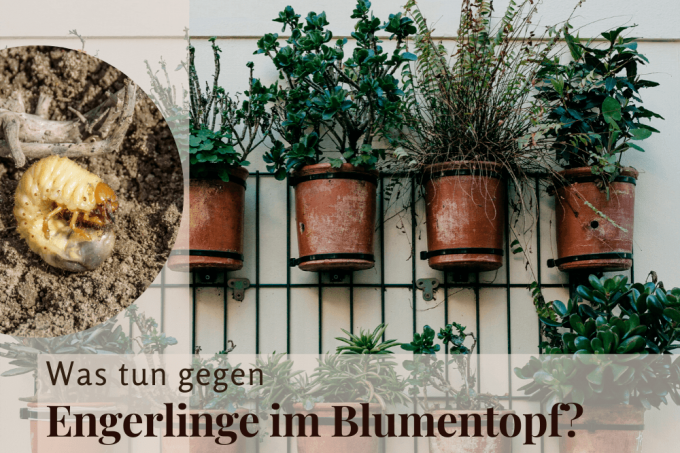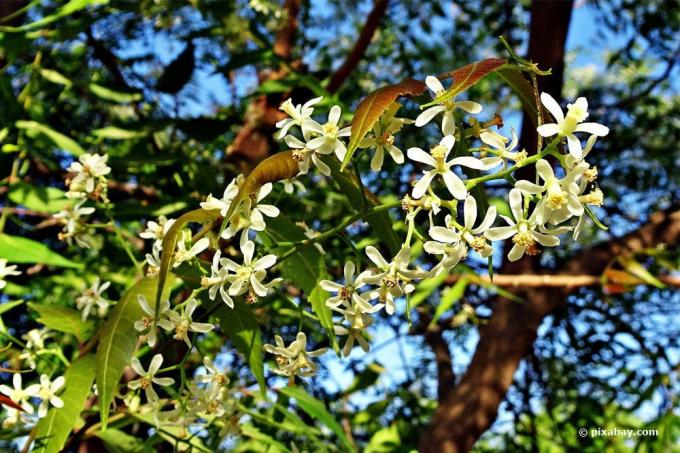
table of contents
- Harmful grubs
- Collecting
- Rinse
- Nematodes
- Neem
- Repot
- Engerling lure trap
White grubs can be harmful to plants in flower pots, but in principle they do not have to be. Basically, only larvae of certain types of beetles count as pests. At the latest when several of them cavort in the substrate, you should consider measures to combat them. Chemical agents are not recommended and can be replaced with environmentally friendly and health-friendly home remedies that are just as effective. The plant experts explain what they are and how to use them.
Harmful grubs
To the White grubs, which are harmful to potted plantsbelong to those who feed on the roots of living plants. Thereby they destroy the roots, the supply of the plant decreases and without countermeasures an affected plant dies.
The larvae of the following beetle species are root eaters and therefore harmful to potted flowers:
- Cockchafer (Melolontha) larvae remain in the ground for up to four years
- Curl beetle (Amphimallon solstitiale) - larvae remain in the ground for around two years
- Garden beetle (Phyllopertha horticola) - larvae remain in the ground for a year
Collecting
If it is a plant with loose roots in the ground, collecting or collecting can provide a remedy in the event of an infestation. All you need are your own hands and a little newspaper. If the soil and the roots have grown tightly into one another, this home remedy is not recommended because it promises little or no success.
This is how the collection technique works:
- Earth should be reasonably dry
- Pull root balls out of the flower and plant pot over newspaper
- Carefully shake off the earth (the first larvae are already falling)
- Push pests out of the earth with your fingers
- Search carefully and proceed as larvae are often also inside the ball of the foot
- Repeat every two days if necessary, if inaccessible larvae have migrated to the outside
- Wrap the fallen grubs in the newspaper and dispose of them
Rinse
If a sturdy plant with strong roots is affected, flushing out is another way of combating white grubs. There are two different approaches here: for minor infestations or for severe infestations.

Small infestation
- Take the plant ball out of the flower pot and place in a water bath
- Water level should be around the entire bale
- If the ball is full of water, the larvae rise
- They swim on the surface of the water and can be collected
- It is important to collect them quickly so that they do not “flee” and reappear later
- Then drain the balls well and let them dry
TIP: This is also a great way to find out if there are grubs in the soil if there is only a suspicion of an infestation.
Larger infestation
- Take the flower out of the pot
- Shake off loose soil over newspaper or the like
- Dispose of the first grubs on newspaper with this one
- Hold the plant ball over a watertight container and "spray" it with a strong water jet
- Once everything has been hosed down on the soil, meticulously examine the roots for further larvae and collect or hose them off
- Collect and dispose of all larvae!
TIP: Even if at first glance no grubs can be seen in the empty flower pot, eggs can still stick to the inner walls. Thorough rinsing with high water pressure or wiping should therefore be part of every grapefruit control.
Nematodes
Nematodes are tiny nematodes that are also known as elk. Among them, there are species that transmit toxic bacteria. If they are eaten by beetles and their larvae, they die quickly. This method of fighting white grubs is one of the most effective.
Corresponding nematodes, such as those from the Heterorhabditis genus, are available from specialist horticultural and plant dealers. The application is simple because they are in closed shells (mostly made of clay), which dissolve through moisture and the nematodes are released. So they only have to be brought into the ground - either by lifting them under or with the watering water.
Neem
Neem products are a herbal active ingredient obtained from the neem tree. This contains numerous natural insecticides that act against beetles and larvae, among other things, as well as acaricides, which are mainly used against mites and ticks.
Neem, also known as neem, inhibits the development of the grubs so that they do not reach the next larval stage and reproduction is not possible. It also inhibits the appetite, which prevents further damage to the roots. Although the larvae do not die immediately, their death is certain. NeemAzal has proven itself as a suitable control agent against the pests in the flower pot. Neem is also available in powder form under other names. Both variants are given into the soil.

Repot
Repotting is actually the safest home remedy for reliably fighting and getting rid of white grubs in the flower pot. However, each repotting also means an additional burden for the flower / plant and can be harmful. Nevertheless, repotting can be life-saving for the plant, especially in the case of extensive infestation, if the roots are badly eaten.
This is how it's done:
- Completely free roots of old soil and grubs
- Dispose of old soil with pests immediately in a closed container
- Rinse / clean roots with light water pressure
- Shorten roots by 1/3 - this strengthens them and usually allows them to recover
- Also cut off damaged tissue and / or dead plant parts above ground
- Plant the plant in fresh substrate (use a clean pot / flower pot)
- Pour lightly
- Fertilize after six weeks
Engerling lure trap
During the winter, the lure trap home remedy for controlling white grubs is not suitable for indoor plants. This is due to the sensitivity to cold as well as the smell and hygienic reasons of the attractant in the house, because the trap is made of horse manure.
If an infestation is spotted in early spring / summer, indoor plants can be placed outside. Then the lure trap is a reliable control measure against white grubs, as well as for outdoor plants in tubs or flower pots.
That's how it's done:
- Fill the bucket with horse manure to about ten centimeters below the rim
- Alternative to horse manure: rotten compost (does not work as effectively)
- Dig the bucket into the ground up to the edge (about 40 to 60 centimeters deep)
- Fill in the soil and mark the location
- Place the flower pot / bucket in the immediate vicinity (ideal: right next to it)
- Horse manure attracts fresh / young grubs
- Buckets should be left in soil for four to six months to ensure that larvae have migrated from the last egg
- Larvae remain in the manure and can easily be disposed of with it
- Recommended: always leave the bucket buried from spring to autumn in order to stop future generations
NOTE: The lure trap only works with young larvae. Older ones remain unaffected and if necessary can be combated with another method mentioned here.



